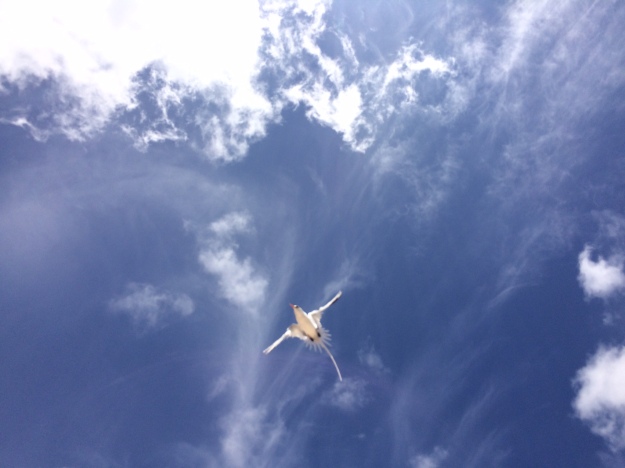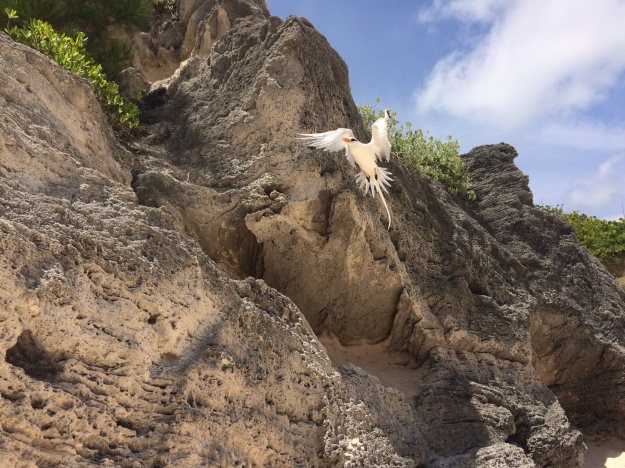Phaethon lepturus catesbyi
Long tails are everywhere this month and my daughter has taken some pretty amazing photos so it seemed apposite to write a post about them.
The full latin name is Phaethon lepturus catesbyi
Phaethon was the son of the Helios and Klimene who kept pestering his father to be allowed to drive the chariot of the sun, but when the sun god finally gave in predictably the young demigod lost control of the vehicle and thus set fire to the plains of Africa – there is a lesson there somewhere, one I certainly took a long time to learn (penknife to 10 year old son? hamsters as pets?) but at least my mistakes didn’t set the earth on fire.
lepturus, although a Latin word here, comes from the Greek meaning “thin tail”
Mark Catesby was an English naturalist who, in 1722, travelled to Virginia and the Caribbean to study the wild life. He was sponsored by the Royal Society of London and paid an annual salary of £20, which was pretty generous in those days especially as he stayed with his sister who lived in Virginia so didn’t have to fund his own board and lodging. He was one of the first academics to describe bird migration and in 1747 he published a book “Natural History of Carolina, Florida and the Bahamas” in which appears the following plate of a long tail:
The original plates and preparatory drawings are apparently held in Windsor Castle Library.
The common name for them is “white-tailed tropic bird” and they are different from but related to the red-tailed and red-billed versions of the tropic bird. Some sources claim there are just three species but a recent survey in Australia suggests some inter-species breeding and birds with mixed features.
You can, I presume, work out how to recognise them – they have long tails! These are two very long feathers trailing out behind the bird, used in the aerial courtship displays. Juvenile birds don’t have them, but after two years at sea they return to their breeding place with impressive long tails of their own.
The nests are holes in the cliffs, some pretty close to the ground or sea level and the egg is laid on bare ground, the parent birds don’t actually make a nest as such. The single egg, a beige colour with purplish and reddish blotches, is incubated by either parent for 40-42 days and hatches in June or July. Juveniles have yellow bills and less distinct black markings and they are fed, again by both parents, on baby squid and small fish. I actually saw 5 tiny baby squid a week ago when snorkelling and was looking for them yesterday but now I realise they have probably been eaten as we have several pairs of nesting long tails on the islands in Harrington Sound.
After around 65 days the young bird will fledge, taking off from the rock face it is a “fly or float” experience – most succeed but every year the local zoo takes in some birds who have failed to reach take-off velocity, returning them to the wild once they have learned the basics. Then they don’t return for the next two years, they fly for the most part all the time and even sleep on the wing.
The markings include a black surround to the eyes which is nature’s equivalent to sunglasses, reducing the glare an reflection from the water so they can see the fish more easily. They do plunge into the surface waters to catch fish but often pick out small fish as they break the surface of the water – flying fish.
The wings from the top have a black V-shaped marking and the wing tips are also black.
The pictures I have are all probably adult birds since they have reddish beaks and the youngsters have yellow beaks.
Historically they were named the “Bosun bird” because their call is akin to the bosun’s whistle. Wikipedia describes the call: keee-keee-krrrt-krrt-krrt . I hope you got that – don’t get the spelling wrong the extra r in the third word is most important! I can hear them out there this morning, but haven’t yet worked out how to attach a sound recording to the blog.
Sadly they are threatened by erosion of rocks, predators such as rats and cats, flooding and building works. Although protected in Bermuda by the Protection of Birds Act 1975, I am not convinced the act is enforced with any regularity on the island. There could be a conflict of interests – once the unofficial bird of Bermuda, the longtail was ousted from this distinction by the cahow in 2003 and the newer igloos are apparently designed to favour cahows and prevent long tails from nesting in them. Igloos are man-made nesting boxes that one can install on your coastal property. Our landlord has made special holes in the rock walls alongside the dock and slipway and although I don’t think there are any nesting this year we do try to keep away from them when we are on the water. Personally I think the longtails are prettier birds than the cahows.








